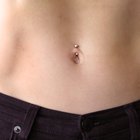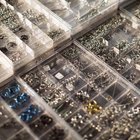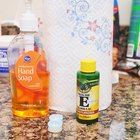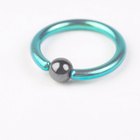
Though professional navel piercing is relatively inexpensive, many people prefer the convenience of piercing at home. When piercing your own navel, it is important to have the proper equipment. Simply pushing a pin through your skin will not result in a proper piercing and may lead to infection or rejection of the jewelry. A navel piercing is not terribly painful for most individuals, but you should be prepared with a pain reliever and anti-inflammatory to ease any discomfort you feel after performing your piercing.
Wear a pair of gloves to help prevent contaminating your piercing with dirt or bacteria. If you do not have gloves, wash your hands twice thoroughly with hot water and soap.
Disinfect your tools with rubbing alcohol. You can use a shallow bowl or cup filled with alcohol to submerge your equipment, including the piercing needle and jewelry, or rub an alcohol-soaked cotton ball over the tools.
Select the location for your piercing. A navel piercing is typically above the navel, but the distance from your navel depends on your preferences. Look at yourself in a mirror and hold the jewelry in various places until you decide how you want your navel piercing to look. You may find it helpful to mark the chosen spot with ink.
Douse a cotton ball with rubbing alcohol and disinfect the entire area around your navel. Repeat this process a few times, using a clean cotton ball each time. Cover a large area, making sure to disinfect the site of the piercing and your navel thoroughly.
Wrap an ice cube with a paper towel, and hold the ice to your navel for one to two minutes. This will numb the area and reduce the pain and swelling caused by the piercing needle.
Push the piercing needle slowly through your navel. Make sure that you continue to breathe during the piercing process. Not all individuals experience bleeding during a navel piercing, but be prepared to see a few drops of blood.
Remove the needle, and immediately insert the navel ring into the hole. Your skin will begin to close right after you remove the piercing needle, so the pain of putting the ring into the piercing will be minimized the faster you insert it.
Related Articles

How to Gauge the Ears Right After the ...

How to Put in a Hoop Nose Ring

Taking Care of Gauged Ears

Professional Way to Clean an Eyebrow ...

How to Change Pierced Earrings

How to Remove a Navel Piercing

How to Swim With Belly Button Ring

How to Remove a Captive Navel Ring

Complications of Nipple Piercing

How to Remove a Labret Piercing

How Is Nipple Piercing Performed?

How to Put in Double Flare Ear Plugs

How to Take Out a Cartilage Earring ...

How Do They Pierce Your Ears With ...
How Soon Can I Change My Belly Button ...

How to Stretch Your Lip Piercing

How to Clean Your New (Conch) Ear ...

How to Drain a Cheek Piercing

How to Open Pierced Ears That Have ...

How to Clean Nose Rings
References
Writer Bio
Brian Richards is an attorney whose work has appeared in law and philosophy journals and online in legal blogs and article repositories. He has been a writer since 2008. He holds a Bachelor of Science in psychology from University of California, San Diego and a Juris Doctor from Lewis and Clark School of Law.
Photo Credits
Wet navel with sand image by Dmitry Sosenushkin from Fotolia.com